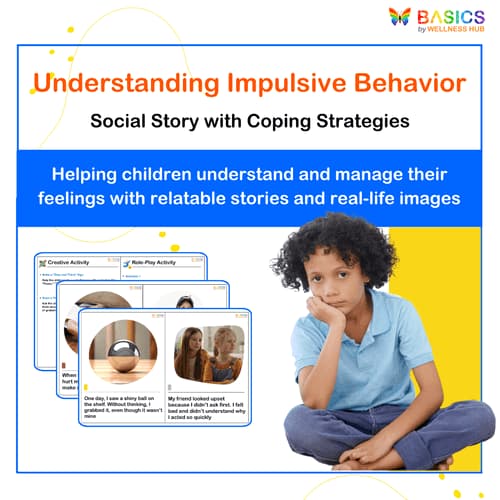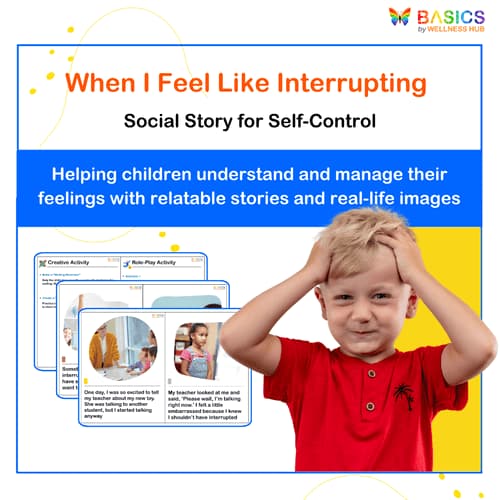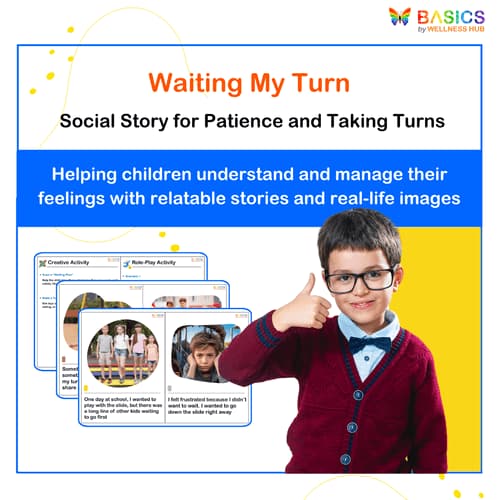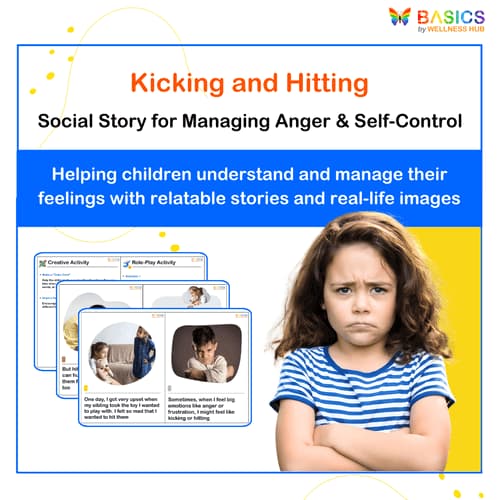





Managing Jealousy - A Social Story for Kids
₹80
₹160
50% off
0 (0 ratings)
Grade Levels
Preschool - Grade 2 (Ages 3-7)
Content Overview
Format: 1 PDF, 6 pages Features: Real-life images, first-person narration, relatable scenarios
Pages from the Resource
This social story, "Managing Jealousy," helps young children understand and navigate feelings of jealousy. With first-person narration and real-life images, the story is relatable and supportive, guiding children through emotions in a gentle and age-appropriate way.

Page 1

Page 2
What Users Say
0
0 ratings
5
0+
4
0+
3
0+
2
0+
1
0+
5 Stars
Product is Good to use.
10 months ago
Varsha Parent
Similar Products

Understanding Impulsive Behavior: Social Story with Coping Strategies
₹ 80.00
₹ 160.00
50% off
4.9 (42 ratings)

When I Feel Like Interrupting – Social Story for Self-Control
₹ 80.00
₹ 160.00
50% off
4.8 (60 ratings)

Waiting My Turn – Social Story for Patience and Taking Turns
₹ 80.00
₹ 160.00
50% off
4.7 (56 ratings)

Kicking and Hitting – Social Story for Managing Anger & Self-Control
₹ 80.00
₹ 160.00
50% off
4.6 (52 ratings)

Understanding Swear Words – Social Story for Respectful Communication
₹ 80.00
₹ 160.00
50% off
4.9 (48 ratings)
About the Product
Purpose of Flashcards: The "Managing Jealousy" social story is a specially designed resource for young children to help them understand and manage feelings of jealousy. This resource is presented in a relatable, first-person narrative, accompanied by high-quality, real-life images that visually support each part of the story. By guiding children through common situations that may evoke jealousy, this story helps them recognize and express their emotions in a positive and constructive manner. The story is presented in a continuous format, making it easier for children to connect with the content and engage in the narrative. The simple, yet impactful language used in this resource makes it suitable for both neurotypical and neurodiverse children.
Product Details
Format: 1 PDF file
Total Number of Pages: 6 pages
Story Structure: 2 statements per page with corresponding real-life images
Image Quality: High-resolution, realistic images that are contextually relevant to the story
Language: Simple, child-friendly, first-person narrative
Purpose: Help children recognize and manage feelings of jealousy, promoting emotional regulation and positive behavior
Age Range: 3-8 years
Grade Level: Pre-K to 2nd Grade
Features: Continuous storyline, realistic imagery, clear and relatable messaging
Educational Benefits
Emotional Awareness: This resource supports children in identifying and understanding the emotion of jealousy. By giving the emotion a name and connecting it to everyday situations, children learn to recognize when they are feeling jealous and understand that it is a normal emotion.
Emotional Regulation: The story offers strategies for managing jealousy in healthy ways. It introduces concepts such as talking about feelings, taking deep breaths, and practicing gratitude, which can be applied in real-life situations.
Social Skills Development: The story promotes empathy and understanding by helping children see situations from multiple perspectives. It encourages positive social interactions and conflict resolution in situations where jealousy might arise.
Language Development: As children listen to or read the story, they are introduced to new vocabulary and phrases related to emotions and social interactions. This enhances their language skills and ability to articulate feelings.
Instructions for Use
Reading the Story: This social story is most effective when read in a calm, quiet environment. You can read it aloud to younger children or allow older children to read it independently. Encourage the child to pause and reflect on each page, asking questions like “How do you think the child in the picture feels?” or “Have you ever felt this way?”
Repetition: Consistency is key for social stories. Reading the story multiple times will help reinforce the concepts and strategies. The more familiar the child becomes with the story, the more likely they are to apply its lessons in real life.
Discussion: After reading the story, have a discussion with the child. Ask them to share a time when they felt jealous and how they handled it. This opens up a dialogue about their emotions and provides an opportunity to practice the coping strategies mentioned in the story.
Role-Playing Activities: Use the scenarios in the story for role-playing. This allows the child to act out different situations and practice the coping mechanisms in a safe environment. Role-playing can be a fun and engaging way to deepen their understanding of managing jealousy.
Integration into Daily Routine: Encourage children to use the strategies learned from the story in their everyday life. Caregivers and educators can gently remind them of the story during moments when feelings of jealousy arise, helping them apply the concepts in real time.
Activities Using the Resource
Storytime Reflection: After reading the story, encourage the child to reflect on the different scenarios presented by asking open-ended questions like, “What would you do if you felt jealous?” or “What could you say if you’re feeling left out?” This activity helps the child relate the scenarios in the story to their own experiences and practice expressing their emotions.
Emotion Journaling: Have the child draw or write about a time they felt jealous, illustrating the scenario, their emotions, and how they managed those feelings. This can be done in a simple notebook or on a printed template. The activity encourages emotional expression and helps children develop self-awareness and coping strategies.
Role-Playing Situations: Use scenarios from the story to role-play situations where jealousy might arise. For example, act out a scene where one child receives a new toy and another feels left out. Guide the child in expressing their feelings and practicing positive responses. This role-playing activity allows children to rehearse appropriate reactions in a safe and supportive environment.
Calming Techniques Practice: Introduce calming techniques mentioned in the story, such as taking deep breaths or focusing on positive thoughts, and practice them with the child in a calming corner or dedicated space at home or in the classroom. This activity helps children learn and internalize self-regulation skills that they can use whenever they feel overwhelmed by jealousy or other strong emotions.
Positive Affirmation Craft: Organize a craft session where children create their own “positive thoughts” cards, decorating them with affirmations like “I am happy for my friends” or “I have many special things too.” These cards can be kept in a special box and used whenever they need a boost. Encouraging positive self-talk through this activity helps children build resilience and develop a healthier mindset when dealing with emotions like jealousy.
FAQs
Q1: What age group is this resource suitable for?
A1: This social story is designed for children aged 3-8 years, typically from Pre-K to 2nd Grade. It is beneficial for both neurotypical and neurodiverse children who need support in understanding and managing emotions.
Q2: How often should I read the story with my child?
A2: Consistency is key. Reading the story regularly—especially during calm, relaxed times—helps reinforce the concepts and strategies. Over time, your child will become more familiar with the coping skills presented in the story.
Q3: Can I use this resource for group activities?
A3: Absolutely! The story is perfect for both individual reading and group activities. It can be used in classrooms, therapy sessions, or even family reading times, with follow-up discussions and role-play exercises that involve multiple children.
Q4: How do social stories like this one help children?
A4: Social stories present complex emotions and situations in simple, relatable narratives that children can easily connect with. By seeing realistic images and reading about common scenarios, children learn to recognize, articulate, and manage their emotions more effectively.
Q5: Is this resource suitable for children with special needs?
A5: Yes, the resource is especially beneficial for children with developmental delays, Autism Spectrum Disorder (ASD), and other special needs. The clear, visual storytelling and realistic scenarios make it easy for all children to grasp and apply the concepts.
Usage Rights and Restrictions
Personal and Educational Use Only: This resource is intended for personal use at home or educational use in classrooms, therapy sessions, and similar environments. You may print or share the resource within these settings as needed.
Non-Commercial Distribution: Redistribution of this resource for commercial purposes, including selling, reselling, or repackaging it, is strictly prohibited.
Digital Sharing Limitations: If sharing the resource digitally (e.g., sending it via email to another caregiver or educator), please ensure the original file remains unaltered, with credit given to the original source.
Modification Restrictions: Do not alter or modify the content, text, images, or layout of this resource without permission from the creators. This ensures the integrity of the content and message remains intact.
Copyright Notice: The resource is protected by copyright laws, and all rights are reserved by the creators. Unauthorized use or reproduction beyond the stated purposes is not allowed.
Conclusion
The "Managing Jealousy" social story is a carefully crafted tool designed to help young children develop emotional literacy and healthy coping mechanisms. By presenting real-life scenarios in a relatable, story-like format, the resource empowers children to understand their emotions and manage feelings of jealousy with confidence and empathy. Whether used at home, in a classroom, or in therapy, this social story provides a safe and supportive way to explore emotions while teaching valuable life skills.



